
As one gets older, the history of the family and where one originated becomes more interesting. Well, it did with me. I have found out a lot about the Hague family, some from my own research and some where I matched into someone else's web publication. Scaramouche's father always said two things about the family: that we had come from "up north", and that the name originally came over with William the Conqueror. That latter idea is by no means uncommon in families, though rarely can it be proved, and my family is a case in point. I think the family name changed over the years, so tracing it back further than I have done will be very difficult. But it seems his other idea may be grounded in fact, we appear (at the earliest stage in our history I have got back to) to be "Yorkshire folk". There are Hague's still in Bradfield and Sheffield, Yorkshire, who may be very distant cousins.
I should say the earliest spellings of the name in Bradfield Yorkshire appear to have a French flavour: Hayge, Hauge, de Hayge etc. I wonder if my father had something, though how he would have known is beyond me, unless the history had been passed down from father to son.
The Web-site: Hague Name History has a lot about the name and its variations, including a family crest, though I am doubtful the latter is a "real" object.
A kind lady named Karen has been doing some research (June 2017) for another Hague, and has given me a great deal of possible sources which might help to get further back, and perhaps strengthen (or not) some of my "possible" links. The origin of the name (and its variations) may be Scotland, then even Norway! I will need to allocate some serious research time to investigate her suggestions, which means my book on HMS Victoria will fall even further behind! Thank goodness I am retired, my days are full to the brim without the complication of "Work"!
Karen has unearthed so much data I am going to need a while to absorb it all. But there are some highlights I would like to share:
Karen seems to have made a distinct link from Hague in England to Haig in Scotland. She has unearthed a source which could take the Haig name back to 839! It seems that some members of Clan Haig residing at Bemersyde in Scotland relocated to England: Lancashire and Yorkshire; and may then have spread to Lincolnshire, with the name spelling changing at some point. She has also unearthed a bewildering array of name variations which may all be related: Haghe, Haughe, Hayghe, Hogg and many others.
The data in this section are personal to me, so please do not make any use of them except for your own research, without just asking me first. Feel free to contact me me about anything, especially if you are a close or distant relative (or a solicitor with a huge unclaimed inheritance).
Though he is not in the Hague line, Mr. Aaron Longhurst, of the immensely powerful and influential Surrey Longhursts, able to trace their line back to 1515, is the cad & bounder who in 1786 seduced a poor, decent, honest serving wench named Elizabeth Thorndale, and thus started a family line of which I am today a member. I suppose I should really be grateful?! As he is a direct ancestor, I must forgive him. Elizabeth is my four greats grandmother, on my mother's side. It seems that although the Longhurst family appear to have acknowledged paternity, they did not agree to a marriage between Aaron and Elizabeth, so I think my interpretation of the situation is likely correct.
I have recently found out that Elizabeth Thorndale may have been the mother of at least 3 children (including Aaron), all of which bear her surname. If Aaron was illegitemate (which he definitely was), what does that mean for the other two also using their mother's surname? The three possibilities are that (i) they were all illegitemate (!), or (ii) Elizabeth was in fact married to a Thorndale, but that she had a (middle) child fathered by Aaron Longhurst, or (iii) the other children were from another Thorndale family living in the same area at the same time with a mother of the same name. The latter two seem a little awkward, but the former is also somewhat unusual for the eighteenth century, as is, by the way, naming the father. I can't explain it any other way than these three choices, and I tend to favour the third.
In 1810, a local Farmer in Swinderby, Lincolnshire, Mr. Joseph Caunt, another Cad and Bounder, seduced (or worse) the daughter of one of his farm labourers. This swine didn't get away scot-free, as a local order in Lincoln against him "Order for maintenance of bastard children" ref "SWINDERBY PAR/13/6/2" shows. Elizabeth Hague (my great-great-great-great-aunt) later married John Johnson in 1820, who seems to have taken on her son Thomas as his own son. Thomas Hague was christened on 21 December 1810 and married Sarah Burrel in 1842 with his step-father as witness. Joseph Caunt had married only a few months before Thomas was conceived. As this so-and-so is not an ancestor of mine, Mr. Joseph Caunt is not forgiven, but his wife was the daughter of a Hague and is a relation. In fact, Elizabeth was Joseph Caunt's wife's cousin. Actually, he lived to a ripe old age, was very wealthy, and later had a number of legitimate children, but seems to have had nothing to do with his first born son. I have been in contact with a gentleman to whom his 6 greats grandparents (via Joseph Caunt's wife) are my 5 great grand parents, so we are 6th cousins, once removed.
My second cousins (once removed), the famous brother and sister film producers of the 20th Century, Sydney Box (who won an Oscar in 1946/7) and Betty Box, producer of the "Doctor In ..." films and many others, and whose husband Peter Rogers of "Carry On ..." fame died in 2009. More about them in WIT's Epilogue page.
Joseph Hague, served on HMS Prince at the Battle of Trafalgar. Originated from Huddersfield close to where my Hague ancestry was living at the time. [ADM 36/16274]
Edward Grey/Gray, served on HMS Victory at the Battle of Trafalgar. Originated from Weymouth area of Dorset where my Gray ancestry is located. [ADM 36/15900]
William T. Hague, Able Seaman, HMS Queen Mary, killed in action at the Battle of Jutland, 31st May, 1916.
Please use the quick-links below if you know the name of someone who perhaps interests you:
The earliest references to, and a brief history of, the Hague name can be viewed at this Surname Database site. It reports the 1589 spelling as Hague, but in fact, the spelling in the quoted source is Hayge.
I have found quite a bit about our earlier Hague's by linking in an ancestor I had found with an ancestor someone on the web had also found as part of his line. The earliest Hague I had found till then was Robert Hague born 1791 in Swinderby, Lincolnshire.
Presuming our line to have originated (as far back as I have got) in Bradfield, Yorkshire, the on-line Bradfield Register records the earliest instances of our spelling of the name as follows: Marriages (1559-1715): William Ashford and Elizabeth Hague, 4 December 1662; Burials (1559-1715): Anne, wife of Thomas Hague 14 November 1661; Baptisms (1559-1715): Sarah, daughter of Robert Hague, 13 April 1662. I have no idea of the relationships, if any, between these persons, and they do not appear in the line on this page.
There are two records which might be for Thomas Hague, the other potential start of this line, in the Bradfield Registers, the nearest being Thomas Haigh born 1651 (too young) and Thomas Haughe, son of Raph Haughe, born 1624. This latter is a possible ancestor but cannot be proven. There is no sensible data for Raph, the only record being a Raphe, born 1562 (surely, too early), son of John Haghe.
It is therefore only proper to start my line with either John Hague born c.1660 who had a son John born approximately the right time, or the Christopher Hague born 1663 who also had a son John born at the right time. I favour Christopher at this time. Actually, since I know, with not 100% certainty but still quite high, Christopher's grandfather Stephen, it starts with him.
Stephen Hague. No details known, other than one son, Thomas.
Thomas Haigh. Wife Mary Sendus married 22nd August 1654. Surname spelt differently at some stage. Buried 15th July 1694.
According to that other person, Stephen Parkhouse, see his web page here for the first John Hague, the first Hague who might be a part of my male line is John Hague, born c. 1660 in Yorkshire or possibly Lancashire. Stephen is quite sure this John Hague IS in the line that extends from my family, but I haven't located the source on which he bases that belief. These counties are where still today the majority of the name are to be found. At some point he married Mary, surname unknown, and a son, also named John was born c.1690, again in either Yorkshire or Lancashire. The birth and death dates of the first John Hague are not known.
In my research, I have found that a John Hague married a Mary Woodcock or Woodcoke in Bradfield Yorkshire on 24 June 1688. This is close to the birth date recorded for the second John Hague (see below), and the wife's name is a match (though Mary was a very common name). However, I cannot assume it is my ancestor and his child. A number of surnames Hayghe, Haighe, Haughe and similar can be found in the Bradfield Parish Registers from 1559 (available on-line as a pdf on this web page) but beware the download is big, about 24Mb. These are possibly earlier spellings of the family name, but that earlier incorrect reference to a Hague in Bradfield in 1589 maybe negates that. Even today, there are loads of Hague's in Bradfield. The son of John, also John, was born c.1693, according to that other webpage. Unfortunately, the Bradfield Registers only record a John Hague born 14th February 1693 as a son of Christopher Hague, so this may not in fact be a valid line. In fact, because of the uncertainty, I am going to assume at this time that there is an error in the line on Stephen's web page, and that the John Hague born c. 1660 is probably not my ancestor. The Bradfield Registers give me a different line, but I may have to revise this assumption in the future!!
So this man is one of two potential fathers of John Hague (1693-1741), the latter I am certain forms part of the line.
This man is the other potential father of John Hague (1693-1741) who I am certain forms part of the line. Christopher Hague was baptized 29 May 1663 in Bradfield Yorkshire. There is no record of a marriage in the town, so presumably his was held at the brides location, as was usual at the time. He had children John (b. 8 Sep 1688, buried 3 Aug 1689), Anne (27 Oct 1689), Thomas (b. 13 Dec 1691, buried 24 Mar 1694), another John (14 Feb 1693), Elizabeth (12 May 1696), another Thomas (13 Mar 1697), William (4 Apr 1701) and finally Sarah (8 Sep 1704).
I am 90% certain this man is the father of John Hague born 1693 who was my six greats-grandfather as detailed next.
So I have two potential fathers of this John Hague who is, I am certain, part of the ancestry. I am doubtful that I will reconcile which it is in reality, but I am 90% convinced it is Christopher born 1663 in Bradfield Yorkshire.
The John baptized 14 Feb 1693 in Bradfield Yorkshire was a farmer, and appears in Swinderby in Lincolnshire in around 1710 (but certainly after 1704), possibly with his father. The previous county boundaries makes this a very short move from Yorkshire. This second John Hague married Sarah Frith in Swinderby, on 14th November 1715. She had been born in Swinderby in 1686, the daughter of John and Mary Frith. John and Sarah had at least five children: Sarah (1716-1718?), another Sarah (1719-), Susannah (1721-), John (1723-1815), Anne (1725-), with two possible additions Jane (?-1728) and Elizabeth (?-1728) for whom no other data is available. This second John Hague died around 1741, here is a transcribed pdf copy of his will, written in 1739. You can tell from his signature that he was very ill at the time, and the will was clearly written by someone else. The original was very difficult to read, and is held in Lincolnshire Archives. Sarah was born 1686 and died 1755.
This John Hague was believed to be a "Yeoman Farmer" which is quite an important man in the community. The farm seems to have passed down the first born male, so eventually moved out of my Hague line at Samuel (b. 1756). I would very much like to find out details about the farm, whereabouts it was in the area, the employees, etc., and in whose hands it is now, but don't have a clue where to start looking! Perhaps the Lincoln Archives have old land registry documents that might help.
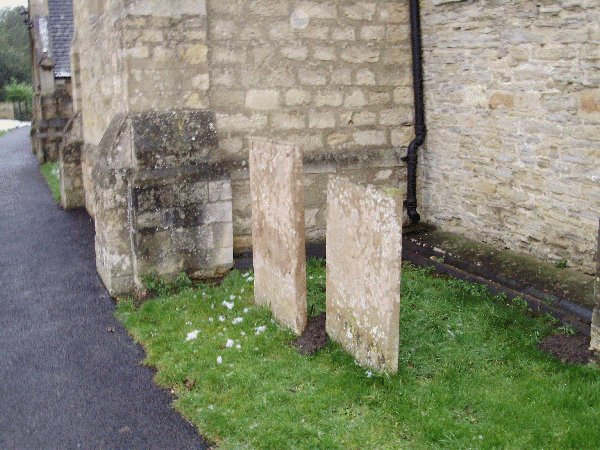
The third John Hague baptized 28 Dec 1723 married Mary Beckett in the village of Swinderby on 24th June 1750. A large number of children were produced, the second son being yet another John, but my line continued with the third male: Samuel, christened 21st August 1756. The children were Elizabeth (1750-?), twin Diana (1750-?), Robert (1751-1828), John (1752-1828), Mary (1754-?), Samuel (1756-1814) William (1759-1829), Anne (1761-?), Sarah (1763-1825). From this point, there are three more possible children, but Mary would have been 49 when the first of these, and 56 when the last of these was born, so I am slightly suspicious as to whether these latter children were part of this family: Richard (1769-1772), Jane (1774-1775), and Susannah (1776-1830).
When John died in 1815 as a widower (Mary his wife had died in 1783), I would have expected the first-born son, Robert to inherit the farm, but according to his will, it passed to John's daughter Sarah, so taking it out of my line. She was aged 52 at the time, and I have not found a record of any subsequent marriage, so how the farm was then owned when she died 10 years later is a mystery. Subsequent members of my line from Samuel appear to have been mostly agricultural labourers. I have tried to find out if there is still a farm in the area owned, or managed, by a Hague, but have been unsuccessful. Given that Sarah died unmarried, it seems possible the farm may have left the Hague line, unless it passed to a cousin of that name. There do appear to still be a number of Hagues, including another John, currently (2016) living in the town, but the internet sites listing them are not very frequently maintained, so the information can be well out of date. One Hague at least, a widow, was receiving "Poor Relief" from the town, so it seems some of the family may have fallen on hard times.
The third John Hague died on February 28th 1815 and was buried on 3rd March. A very worn but upright gravestone in Swinderby's All Saints Church faintly shows a John Hague died aged 92, so is almost certainly the marker for this man and his wife. I have a pdf copy of a transcript of his will, which is held in the Lincolnshire Archives. It was made 17 days before his death. Mary was born 1720 and had died 1783. With reference to "Lincs to the Past" - Burial, Reference Name SWINDERBY PAR/1/7, Date: 1813-1911, Repository: Lincolnshire Archives [057], [page 5] John Hague, Swinderby, 1815 March 3rd, 92, A Chambers Vicar. I am afraid I do not know what a Chambers Vicar might be, and Google is no help.
Samuel Hague was baptized 21 Aug 1756 and married Mary Dunn on 12th August 1790. They had seven children: Robert (1791-1864), Elizabeth (1793-1854), John (1795-1796), another John (1797-1797), Samuel (1798-after 1832), George (1800-1801) and Charles (1801-?).
According to the search records, Samuel was apparently buried 2nd March 1814, though his will states he died on the 3rd. I think I have identified his prone gravestone in the churchyard. Mary was born 1765 and died 1836.
As stated above, in 1811, Samuel issued a Maintenance Order on behalf of his daughter Elizabeth against Joseph Caunt, Farmer, of Swinderby. I have transcribed the order in this pdf article. She was Scaramouche's great-great-great-great aunt and Joseph Caunt's wife Hannah (nee Gibson, daughter of Thomas Gibson and Mary Hague, daughter of John Hague in the previous section) was her cousin. The original is held in Lincolnshire Archives and is so fragile they are not allowing any more reproductions of it. I was lucky that they had a reproduction taken some while ago that I could purchase a copy of. The original was clearly very dog-eared, and they sent me a copy of a copy, which accounts for the gaps in the pdf.
Samuel was at one time a church-warden of Swinderby Church (in 1809).
Samuel Hague made his will which is held in the Lincolnshire Archives, click for a pdf copy of my transcription. Strangely, it makes no mention of his wife, Mary.
Just as with his father, a reference in "Lincs to the Past" - Burials; Reference Name SWINDERBY PAR/1/7; Date: 1813-1911; Repository: Lincolnshire Archives [057]; [Page 4] Samuel Hague, Swinderby, 2nd March 1814, 57 Years, describes him as "A Chambers Vicar" also.
I found in FreeCen for 1851 a Samuel Hague age 52 which may be my g-g-g-g-grandfathers son. He was born Swinderby, but is now farming at Fenton, Nottinghamshire with wife Sarah, sons William, Richard, Samuel, Frederic (age 6 born Swinderby), Walter (aged 1 born Fenton) and daughter Elizabeth. One can therefore surmise he may have moved from Swinderby to Fenton between the years 1845 and 1850. Sarah was born in Fenton c. 1804 so they may have married there around 1830 and perhaps Samuel took up or inhertitted a farm there around 1845.
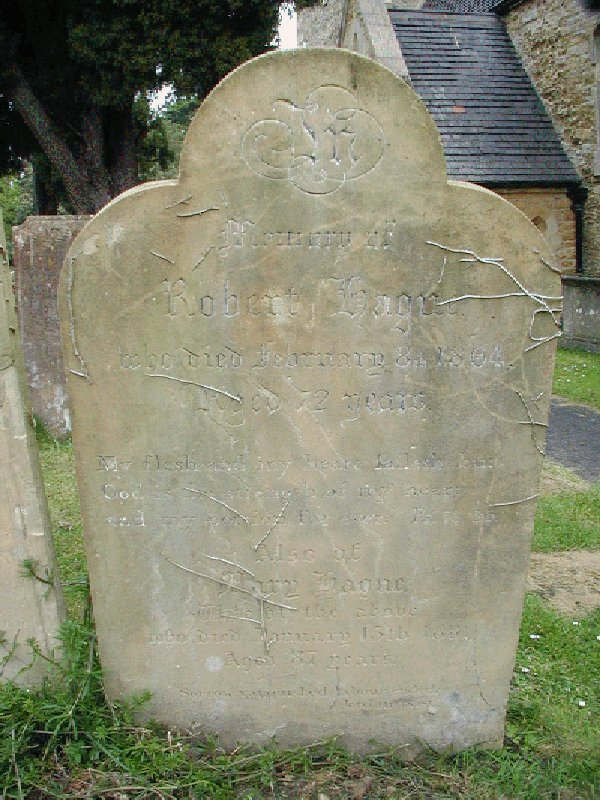
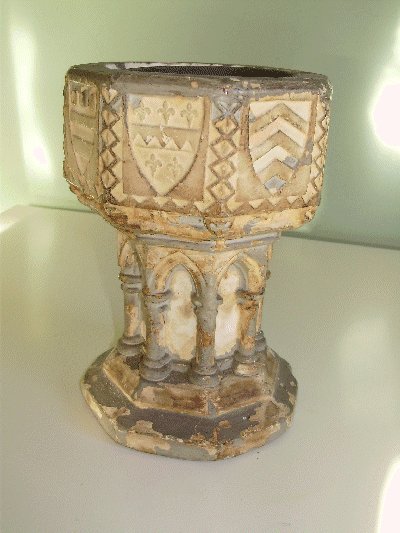
Robert Hague was born 1791 and married Mary Vickers in 1820. They had seven children: Ann (1820-?), Samuel (1821-1884), Robert (1823-1871), John (1825-?), Thomas (1827-1902), Elizabeth (1831-1839) and her twin Mary (1831-before 1841).
This first Robert died 8th February 1864 aged 73 and his wife Mary died 15th January 1881 aged 87. They are buried together in a grave in Swinderby's All Saints Church with a clearly readable upright stone.
I have tended on the side of it being this gentleman who brought the Hague font into the family. Click its image to find out more about it. But it is possible it was his father Samuel who bought it, perhaps for Robert's christening, and who was a churchwarden, but if the font dates to c.1847, that does not work very well, and either this or the next Robert seems most likely.
The 1861 Census records Robert (69) and Mary (67), "Clerk of Church", living next door to Thomas Hague (Agricultural Labourer); wife Anne, and children Charlotte (11); Robert(9); Elizabeth (7); John (5) and Mary Ann (3). These are Robert and Mary's son and his family. They had two more children: Thomas (b. 1864) and Ellen (b. 1866).
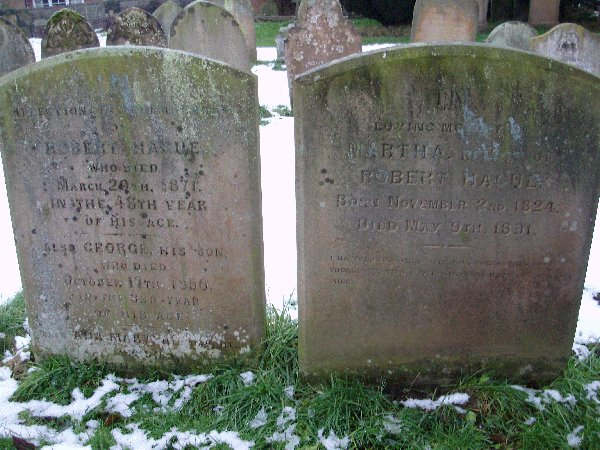
The second Robert Hague born 1823 is one for whom I have more information than just sketchy dates. He was born just before 4th November, 1823 and married Martha Grundy from North Collingham in Swinderby in June 1846 - the date on the certificate looks like the 18th. She had been born 2nd November 1824, the daughter (among many siblings) of Hugh Grundy and Ann Penell. Robert was a worker on the new Midland Railway soon after its inception, and was a station master at North Hykeham, which really meant he tended the gates. I have tried to find some old photos of the station on the internet, but without success. The family lost a number of children very young (like the previous Samuel Hague), but some did survive to have children of their own. The full list of children I have been able to establish is: John (1848-1854); Elizabeth (1850-1854); William (1851-1909); George (1854-1856); Ann (1856-?); Samuel (1859-1896); Martha (1861-before 1871); Ada Mary (1864-1866); and Robert (1868-?). The father Robert died of cardiac disease on 28th March 1871, just before the census, aged just 48. He is buried in Swinderby's All Saints Churchyard with George and Ada Mary, alongside is the grave of his wife Martha who died 9th May 1891.
Something very sad happened to two members of this family: seven year old John and five year old Elizabeth were both buried on the same day: 9th December, 1854. The most likely explanation is sickness. Intriguingly, Samuel Hague's unmarried daughter Elizabeth also died in 1854 aged 61.
William Hague born 1851 joined the railway, and in 1871 became a founding member of the ASRS, the "Amalgamated Society of Railway Servants". This body was one of the earliest organised unions of workers in the country, and the earliest on the railways. A John Hague, quite possibly one of William's cousins, was on the ASRS Nottingham Branch Executive Committee for the years 1874 through 1876. The ASRS was the prime union to join with other railway unions to become the National Union of Railwaymen, subsequently part of the now giant RMT (Rail, Marine and Transport). In 1874 in London, William married Helen Sellwood. They had two children, Ada Mary b.1874 and Charles William b.1878. In 1880, Helen died aged just 26 with the family living in Kettering, Northants. On 22nd November, 1881, William married for a second time, to Elizabeth Ann Coaten from Barnwell. In 1891, William was presented with a writing case by the ASRS, click the link to see more about it.
William became the first of the recent Hague's to move out of Lincolnshire. I believe he must have been stationed as a porter at North Hykeham with his father on the railways for some time for William was born there in 1823, then Islington as a signalman in London where he met and married Helen Sellwood. He moved sometime to Kettering where he boarded with a family, until his second marriage to Elizabeth Ann Coaten and the settling in the town where he died in 1909.
William and Helen had two children: Ada Mary (1874-after 1901) and Charles William (1878-1882), following which William and Elizabeth Ann had seven children: Ernest William (1882-1949), Arthur Robert (1884-after 1910), John Coaten (1886-1970), Charles Nathaniel (1889-1892), Reginald Harry (1890-1979), Walter George (1894-1918) and Amy Elizabeth (1896-after 1925). Walter was a casualty of the First World War, but sadly all his records were destroyed in the Second World War and I know absolutely nothing about him.
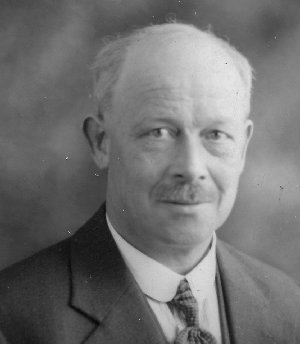
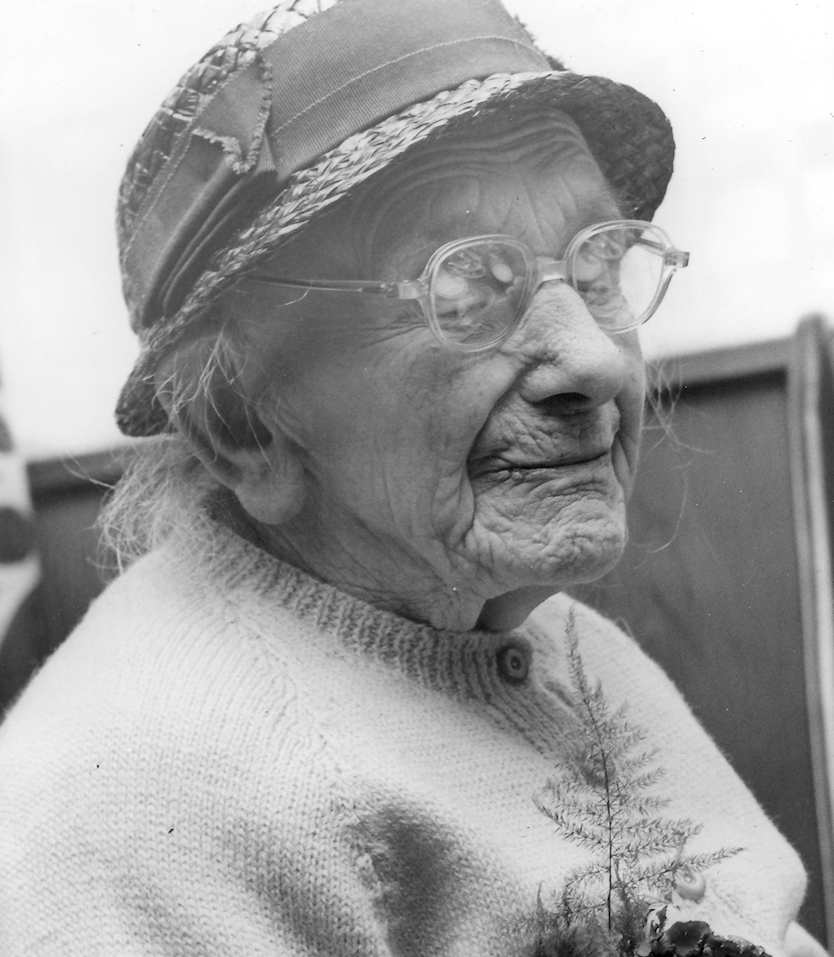
William and Elizabeth's eldest son was Ernest William, born 24th November 1883 at 7 Thorngate Street, Kettering, Northants. His birth certificate records both 1882 and 1883. He worked in the clothing trade for much of his life, and served during the First World War as an anti-aircraft gunner in the Royal Garrison Artillery. He fortunately survived the war, but a brother Walter George Hague did not, and certainly one (Harry Keller), possiby two of his wife's brothers also lost their lives in the conflict.
Ernest seems to have decided not to follow his father onto the railways, and indeed, Scaramouche's father always said his father (Ernest) had been very much opposed to his son joining the railways. After leaving school, Ernest entered the booming clothes trade in Kettering, as did most of his family. At some point in his life (before the war) he lost the top joint of his right hand index finger in an accident. This would later be seen as a blessing in disguise. On the 3rd August 1908, Ernest married Frances Lucy Keller, a machinist and probably a co-worker. She had been born in Wellingborough in 1881, the daughter of Alfred and Lucy Keller.
As you might expect, I tend to watch shows like "Who Do You Think You Are?" and an intriguing parallel emerged on the one with the actress Sheila Johnson. She had a grandfather who joined the railways, and it caused a great rift with his parents. She at first thought it due to snobbery, but it turned out the parents had themselves lived in great poverty for many years of their life, as the husband worked for a pittance on the railway. He had late in life broken away, become a pub landlord, then a hotel owner, and had worked his family away from the back street slums that took his first wife and 3 children from tuberculosis. So he would have been appalled to see his eldest surviving son go on the railway and head for the same dreadful living conditions as he had endured and escaped from. In a like manner, I wonder if Ernest saw his father as living in poverty and ill-health from the railway, and was determined not to follow that same path himself, and was equally determined not to permit his son to follow it either. It sounds very plausible.
Ernest and Frances (known as Ern and Lou) had a daughter, Doris Mabel in April 1910. In August 1911, the family were staying at 9 Manor Road Chelmsford with Ernest's brother Arthur Robert and his wife Ellen, when Doris Mabel died aged 16 months of "Acute Infantile Paralysis and Exhaustion". I don't know if the family had gone there in an attempt to improve Doris' health, but Ernest was certainly present. I remember once on a visit to Grannie Hague coming across a newspaper clipping recording the death of a Hague, and my father saying it was his elder sister. I thought he said she had died of influenza during the 1919 epidemic, but that was not Doris Mabel. But I am also sure he said he had two sisters who had died; if so, possibly a younger sister born during or soon after the war may have succumbed, and would have missed appearing on any census. However, there is no BMD record of a female Hague birth/death in Kettering between 1915 and 1920.
For his war service, Ernest received his call up around the end of 1915. His age would have meant that at the start of hostilities, he would not have been needed, but the massive losses of troops particularly in 1915 meant that any able-bodied man, even a 33-year-old, was likely to be called.
Ernest seems to have passed the medical check OK, with that one little problem that I have already mentioned which, fortunately for him I think, meant he could not be an infantry soldier in France. A section of his right index finger was missing, apparently the result of some earlier accident in his working life. The recommendation from the accepting Medical Officer was that he was "Fit for garrison service at home", but this was later crossed through. So he may have served in France at some time. His vision was given as 6/6 in both eyes, i.e. perfect, and maybe this was what governed his wartime service. He was allocated to the Anti-Aircraft Division of the RGA, the Royal Garrison Artillery. His address was given as 3 Hawthorn Road, Kettering, and his occupation "Woollen Warehouseman". His service number was "86265 RGA".
The Royal Garrison Artillery (RGA) was an arm of the Royal Artillery that was originally tasked with manning the guns of the British Empire's forts and fortresses, including coastal artillery batteries, the heavy gun batteries attached to each infantry division, and the guns of the siege artillery. From 1914 when the army possessed very little heavy artillery, it grew into a very large component of the British forces on the battlefield, being armed with heavy, large-calibre guns and howitzers that were positioned some way behind the front line and had immense destructive power. The corps name was discontinued during the 1920s, after the RGA was re-amalgamated into the Royal Artillery.
This link: RGA gives an excellent background to this less well-documented division of the army. Ernest joined the 19th AA Company of the RGA, with the rank of Gunner. The AA unit Section consisted of 43 men in total: 2 officers, two gun detachments of 12 men each (of which 1 in each was a Driver of the Army Service Corps), 2 telephonists, 1 linesman, 4 height finders, 4 Wilson-Dalby Detector Operators, 2 Height and Fuze Indicator men, 1 Order Board Setter, 1 Lookout man (Air sentry), 1 orderly and 1 cook, all being RGA unless otherwise indicated. By the last quarter of 1916, there were in all 183 Sections consisting of 367 guns in England. In France, there were 74 Sections, made up of 147 guns. There were also 3 Sections in Egypt, 6 in Salonika and 1 in Mesopotamia. I believe that, though the record is badly damaged and much of it is unreadable, Ernest spent part of his war stationed in France, as he was awarded the "British" and "Victory" medals that needed him to have left these shores for a war theatre abroad.
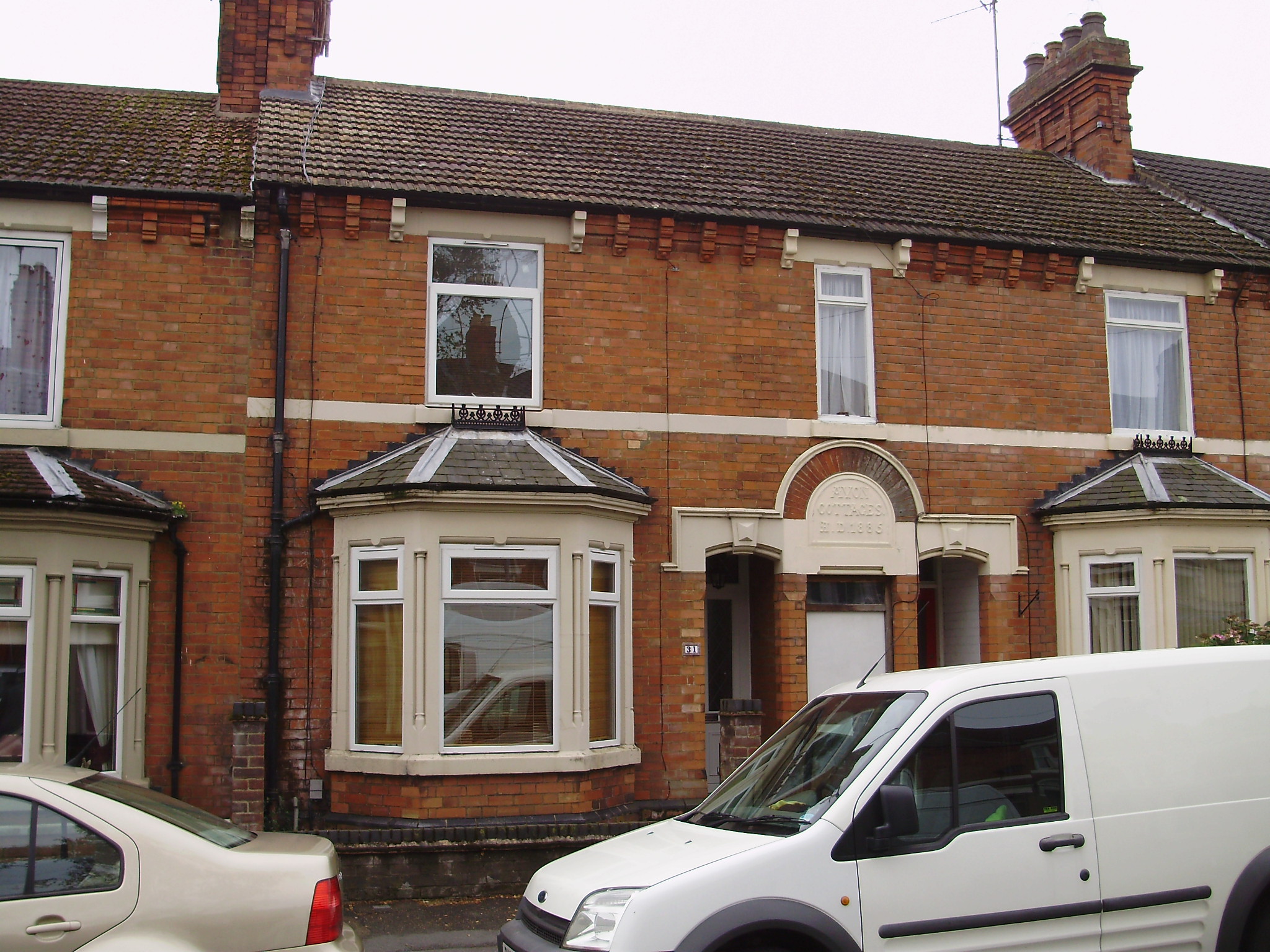
After signing his papers in December 1915, Ernest was posted to No.1 Depot of the RGA (to Fort Burgoyne at Dover) presumably for training, the rest of his posting record is unreadable. His personal particulars were given as "Height 5' 6"; Girth 35 1/2 "; Girth range 3"; Weight 131 lbs." He was obviously of very slight stature, weighing less than 10 stone. Ernest was "de-mobilised" in February 1919, apparently at South Shields. Fortunately, he had suffered no injury or incapacity during the war.
I should say these details are gleaned from two sets of call up papers; this does not seem to be normal though is not actually uncommon, and I think the first set must have been lost, were officially regenerated (and Ernest signed them again), only for the originals to then surface again later. The data doesn't contradict, but each has more detail in some areas than the other.
Another point to make is that we are lucky the papers survive. About 70% of Army WW1 Service records were destroyed during the Blitz in WW2, and most of those that survived were damaged, which is why much of Ernest's record is unreadable. I have found no records for Walter George Hague, which is a great shame as it would tell us where and when he fell, and it is for sure that all Ernest's younger brothers would have faced call up. I am intending to arrange a visit to the Northamptonshire Regimental Archives later this year, but there is no guarantee this is where they would have served - after all, Ernest didn't!
The family lived in "Avon Cottages", at number 31, Hawthorn Road, Kettering. It seems William and Elizabeth moved into the house when it was first built in 1885, and Ernest took it over on the death of his mother in 1916. Ernest and Lucy had been living there with Elizabeth for a few years. The family stayed there until around the mid 1960s, when Ernest's widow Frances Lucy had to enter a home and give it up. I remember the house as a "two-up and two-down" and a kitchen with a huge walk-in pantry, and with an outside toilet, and it staggers me to think that in its early years, it was home to a couple and their seven children! Where they fitted them all is a mystery, and in the 1901 census, they even had a visitor staying with them! I remember the back garden and an old well near the path, the area around which was strictly out of bounds to us younger children. I remember the "front room" or "parlour", which was hardly ever used. We all used the back room which had a piano and a big table full of drawers where the cutlery was kept. There was no television, but a big radio. The few times I did see into the front room, it was like a museum of Victoriana. It was stuffed full of porcelain, pictures, knick-knacks and cupboards, each full of stuff. One thing my mother hated was a grass snake pickled in a glass jar! Why it was considered worth keeping, I don't know. When grannie Hague moved out, Mum and Dad had to clear the house, and being located many miles away, it was very difficult to do much, and most of the stuff went to a clearance firm. Probably today, the stuff would be worth a fortune. I visited in 2009 and took the picture but no-one was in when I called; if the current occupants object to me using it, contact me and I'll remove it immediately.
Ernest retired in 1949 but was already in poor health. Later that year, he died, as I believe, from heart failure, something that had also afflicted his grandfather.
Grannie Hague lived in that same house for many years before infirmity, and the stiffness caused by two broken hips from the steep steps to the back garden and the outside toilet, forced her into a home. She died in the town in 1972.
I do need to make a qualification about the image I have used for Ernest. This table gives some details, but are they all the same person?
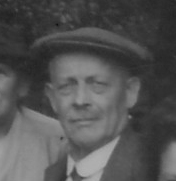 |
This is a guaranteed image of Ernest. It was taken c.1945, most probably around the time of my parents marriage although it may have been a year or two before. |
 |
This is an uncertain image of Ernest on the right, with an unknown gentleman beside him. In my opinion, he bears a strong resemblance to my father, more so when my Dad was the same age, 63. Does he look like the previous image, as I believe both would have been taken around 1945, this particular one with the men in their finery, more probably at the time of a marriage. |
 |
This is a genuine image of Ernest, and sadly shows him a few weeks before his death from heart failure, so late 1949. Although blurred, the image cannot disguise the face of a seriously ill gentleman. |
Ernest and his siblings at the National Archives:
| Name | Service Record (WO363) | Service Number | Medal Record (WO372) | Pension Record (WO364) |
|---|---|---|---|---|
| Ernest William | RGA 86265 | |||
| Arthur Robert | RGA 162413 | WO 372/8/193180 | ||
| John Coaten | ||||
| Reginald Harry | RGA 198048 | WO 372/8/193655 | ||
| Walter George | RGA 172652 | WO 372/8/193811 |
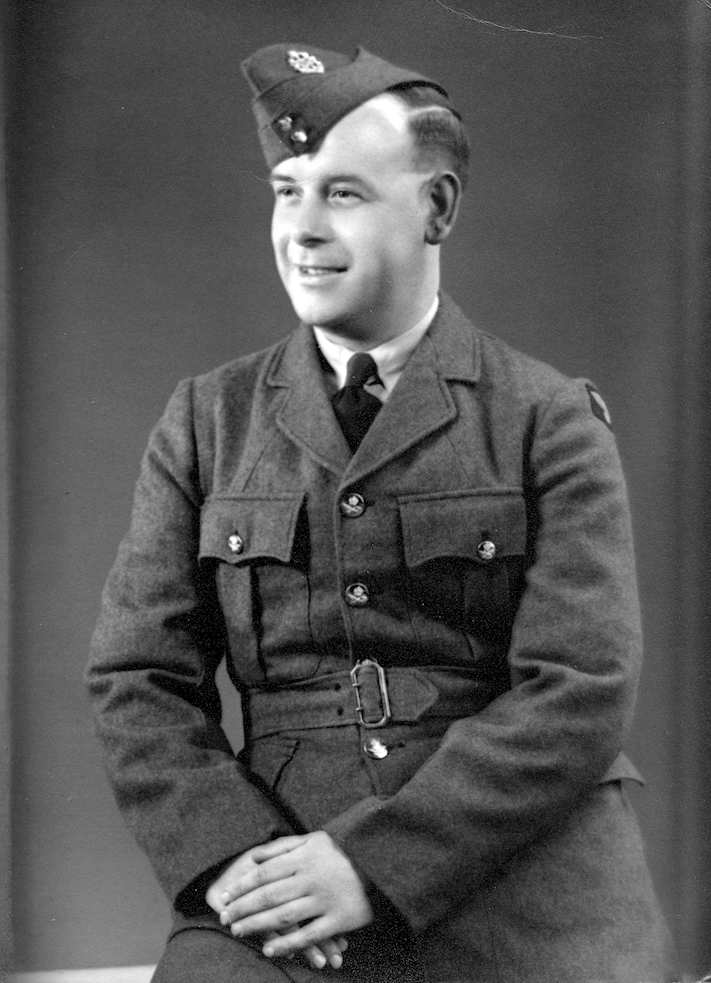
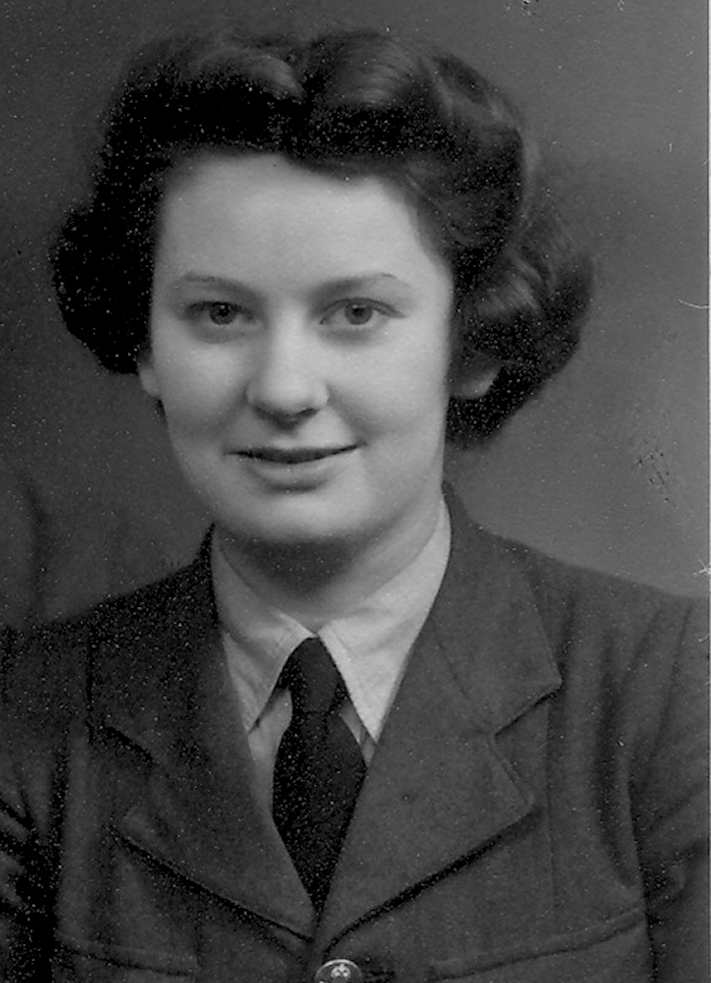
Leslie Walter Hague was my father, born in 1912 in Kettering, Northamptonshire. He remembered as a youngster watching the R101 go over Kettering on its ill-fated trip to France. He wanted to join the railway like his grandfather William, but his father thought him too intelligent to "waste" his life like that, so he went to Kettering Grammar School. Here, he was a contempory of the famous writer H. E. Bates, though they were in different years. He always said the famous author's writings were not his cup of tea. He was much more impressed by the much later efforts of the Science Master Geoffrey Perry and his interception of 1950s Russian satellite radio signals often before the official British observers had realised the Sputnik had even been launched. He left school to work in the local council offices, the work he did was with the Rates working in the Borough Treasurer's Department and he kept it up all his life, but he always had a deep love for the railways. He was an active member of the Higram Players, an amateur theatrical group in Kettering, but I have been unable to find out much about them. This was before the Second World War, of course.
The house at 31 Hawthorn Road Ketering was, I recall, well populated with photographs of football teams, and Dad was always a fan of the sport. I am sure he said that either he, or his father or maybe an uncle, played goalkeeper for the Kettering Town football team. If it was Dad, it would have been around the 1930s; if his father, I guess around 1900-1910. I think it a great shame all the photos have gone. I have tried to find out if any Hague's played for Kettering, but so far without success. The Kettering Town internet site just ignore my e-mails, and I have given up asking.
He was called up in about 1941 aged 29, and was posted to an airfield in Gloucestershire, I always thought he meant RAF Gloucester but there doesn't seem to have ever been one. It must have been one of the many RAF bases in Gloucestershire. He was on ground duties, which he told me involved some secret device located inside the aircraft. He had to load and unload it, and he did tell me the name of it years ago but I have forgotten it. It was here that he met Leading Aircraft Woman (LAC) Frances Winifred Gray, born 1923 in Reigate, Surrey and who had joined up aged 19. The pictures above show them in their wartime RAF uniforms, so both circa 1943. They married 29th September, 1945 at St John's Church, Redhill.
Frances had previously been engaged to an American serviceman, who went "Missing in Action" early in the war. His first name was "Graham" but I do not know his surname, so cannot look for him at the American Services memorial at Madingley, near where I live.
Demobbed in 1946, Dad went back to working for his local councils in Fareham and Shoreham By Sea. Both Mum and Dad were active post-war members of the RAFA (Royal Air Force Association), and Dad was for a long time a part-time member of the Royal Observer Corps, which had such an important role in Britain's defence during the cold war. I remember one Saturday morning, middle 1960s, he took me to an underground shelter on the downs near Southwick, Sussex. There was a big steel and concrete hatch, and a series of iron ladder rungs going down to a series of rooms below, all filled with monitoring and radio equipment. The bunker seems to be still there, but although the hatch is open, the shaft has been sealed. I wonder if anything remains below. I don't know if he was supposed to take me inside (I was about 13), but nobody that was there seemed to mind my presence. There is a comprehensive article here which seems to show the empty rooms below ground. There may be a modern one nearby in Southwick Tunnel, see this article.
I have been able to obtain my parents wartime RAF Service Records, which detail the airfields on which they were stationed, plus some othe interesting data. Unfortunately, Dad's doesn't include that secret wartime device he was involved with, but it may have been the "Gee" radar navigation system.
Leslie spent the after war years working in Local Government in Fareham Hampshire, and then Shoreham By Sea in Sussex at 103, Greenways Crescent in the town (where Scaramouche was born). The family moved to 8 Middle Road, Shoreham around 1956/7 and then to 4 Harbour Way on Shoreham Beach in about 1963, from where Leslie became churchwarden at the Church of The Good Shepherd on Shoreham Beach. Scaramouche has vivid memories of the big fire just across the Harbour Way road from us, it may have been Watercraft Boat Builders. It was a large wooden shed that contained wood shavings and sawdust, and it seems a workman tossed a cigarette butt in it: unwise. It will have been the late 1960s or early 1970s sometime. There was another big fire in the road in 1989/1990.
After retirement, my parents spent time at 52, Rookswood, Alton in Hampshire, and then 24 Ashley Close, Winchester. Frances Hague died in Southampton of pancreatic cancer on 6th April, 1987. Leslie died in The John Radford Hospital in Oxford on 18th July, 1990. They were the most wonderful parents a person could ever wish to have. I just wish I had told them that more often.
My family trees, leading back from my father Leslie Walter Hague, my mother Frances Winifred Gray, my paternal grandmother Frances Lucy Keller, and my maternal grandmother Evelyn Baverstock Thorndale. The children names picked out bold are the persons to appear in the next line of the table as the "Individual".
| The Hague Family Tree | ||
|---|---|---|
| Individual | Spouse | Children |
| Christoper Hague 1663-? | ? | John, Anne, Thomas, John, Elizabeth, Thomas, William, Sarah. |
| John Hague 1693-c1741 | Sara Frith 1686-1755 | Sarah, Sarah, Susannah, John, Anne. (possibly Jane, Elizabeth). |
| John Hague 1723-c1815 | Mary Beckett 1730-1783 | Elizabeth, Diana, Robert, John, Mary, Samuel, William, Anne, Sarah. (possibly Richard, Jane, Susannah). |
| Samuel Hague 1756-1814 | Mary Dunn 1765-1836 | Robert, Elizabeth, John, John, Samuel, George, Charles. |
| Robert Hague 1791-1864 | Mary Vickers 1799-1881 | Ann, Samuel, Robert, John, Thomas, Elizabeth, Mary. |
| Robert Hague 1823-1871 | Martha Grundy 1824-1891 | John, Elizabeth, William, George, Ann, Samuel, Marthe, Ada Mary, Robert |
| William Hague 1851-1909 | Helen Sellwood 1852-1880 | Ada Mary, Charles William. |
| Elizabeth Ann Coaten 1853-1916 | Ernest William, Arthur Robert, John Coaten, Charles Nathaniel, Reginald Harry, Walter George, Amy Elizabeth. | |
| Ernest William Hague 1882-1949 | Frances Lucy Keller 1881-1972 | Doris Mabel, Leslie Walter |
| Leslie Walter Hague 1912-1990 | Frances Winifred Gray 1923-1987 | Bryan Francis Ernest, Graham Leslie Evelyn, Rosemary Frances Winifred. |
| The Gray Family Tree | ||
|---|---|---|
| Individual | Spouse | Children |
| Thomas Gray 1807-1879 | Jane Martin 1811-? | John, Eleanor, Mary Ann, Francis, Grace, Sarah Ann, Ann, Jane, Eliza, Alicia (or Amelia), Rose Hannah, Jasper Henry, Mary Ann. |
| Francis Gray 1838-1907 | Mary Weare 1839-? | Lavinia Mary, Francis William, Charles, SA, Eliza Jane, Rose Hannah (Rosanna), LA, FA. |
| Francis William Gray 1861-1934 | Maria Elizabeth Tucker 1860-1903 | Francis George |
| Ellen Fowles 1875-1952 | John, Marion, Betty. | |
| Francis George Gray 1897-1976 | Evelyn Baverstock Thorndale 1895-1962 | Evelyne Jane, Frances Winifred. |
| Frances Winifred Gray 1923-1987 | Leslie Walter Hague 1912-1990 | Bryan Francis Ernest, Graham Leslie Evelyn, Rosemary Frances Winifred. |
| The Keller Family Tree | ||
|---|---|---|
| Individual | Spouse | Children |
| William 1804-? | Keziah Unknown ?-? | George, Eliza, Henry, Alfred, Charles. |
| Alfred Keller 1837-? | ? | Alfred. |
| Alfred Keller 1856-1922 | Lucy Ann Wright 1854-1929 | Ellen Elizabeth, Annie, Frances Lucy, William Alfred, Harry, Florence Lizzie, Edith, Ernest Robert. |
| Frances Lucy Keller 1881-1972 | Ernest William Hague 1882-1949 | Doris Mabel Hague, Leslie Walter Hague |
| The Thorndale Family Tree | ||
|---|---|---|
| Individual | Spouse | Children |
| John Longhurst 1515-1573 | Amy Unknown ?-? | William, Edward, Thomas, Juliana, Henry, Hugh, Agnes, Christopher, Margaret, Christina, Alice, Walter. |
| William Longhurst 1537-1599 | Elizabeth Unknown ?-? | John, George, William, Thomas, Amye, Margaret, Walter. |
| John Longhurst 1564-1631 | Marie Unknown ?-1623 | William, Mary, Ann, John. |
| John Longhurst 1617-1690 | Elizabeth Unknown ?-1677 | Elizabeth, Joseph, Catherine, Walter, Jane, John, Ann, William, George, Katherine, Edward, Richard. |
| Walter Longhurst 1647-1690 | Sarah Tydy ?-1690 | Sarah, Elizabeth, Jane, Walter, John, David, Ann, William. |
| David Longhurst 1682-1720 | Sarah Chennel 1684-? | William, David, Sarah, Walter, Sarah, John, Moses, Thomas, Aaron. |
| Aaron Longhurst 1719-? | Sarah Cranler 1720-? | Aaron, William, Walter, John, David, Mary, Emilia |
| Aaron Longhurst 1744-? | Elizabeth Unknown ?-? | Aaron, Walter, Sarah, Erward. |
| Aaron Longhurst 1765-1817 | Elizabeth Thorndale 1764-? | Aaron Thorndale (illegitemate). |
| {Martha Nettlefold ?-?} | {William, Henry, John, Edmund, Eliza} | |
| Aaron Thorndale 1786-1835 | Mary Field 1785-1856 | John, Harriet, Peter, William, Charles. William later known as "Thorndell". |
| William Thorndell 1816-1861 | Sarah Mason 1821-1873 | Fanny, Louisa, Aaron, Phoebe, Alice, Henry Michael, Elizabeth (Eliza), Isaac. All later known as "Thorndale". |
| Isaac Thorndell 1861-1949 | Jane Dowling 1858-1939 | Harry, Winifred Sarah, Evelyn Baverstock. All known as "Thorndale". |
| Evelyn Baverstock Thorndale 1895-1962 | Francis George Gray 1897-1976 | Evelyne Jane Gray, Frances Winifred Gray. |
Note the Thorndale/Thorndell name changes during the family's history. And part of the line involves an illegitemate link.